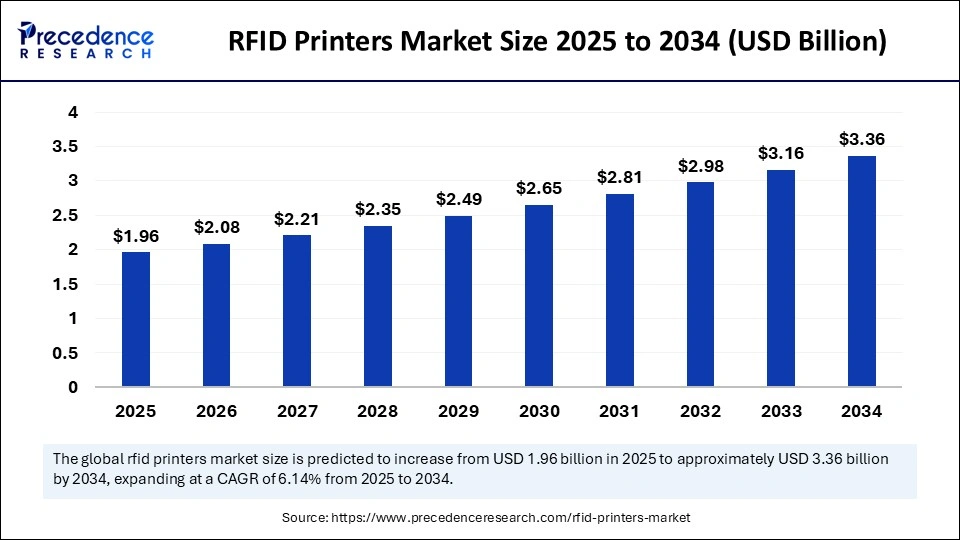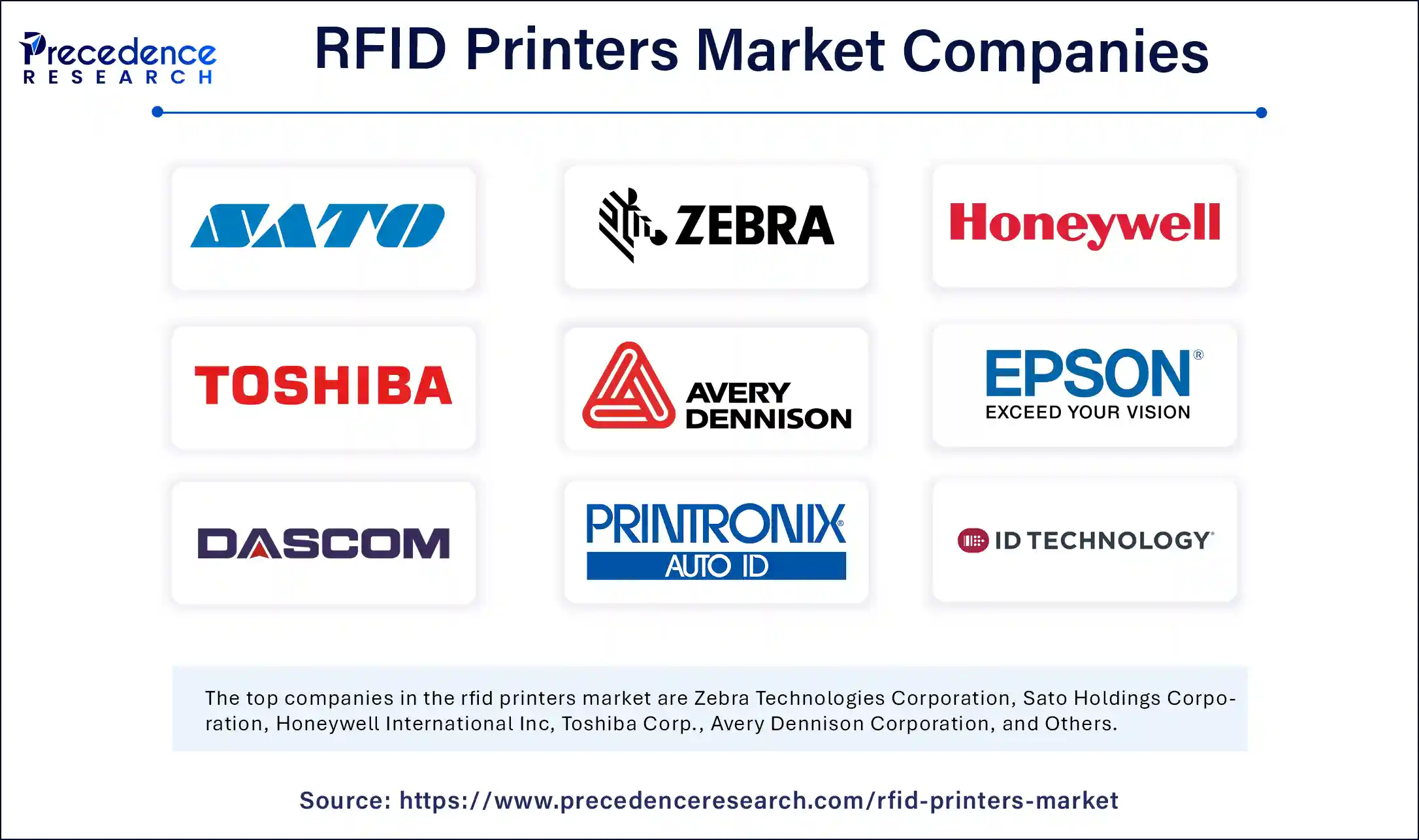
RFID Printers Market Key Points
-
North America dominated the RFID printers market in 2024.
-
Asia Pacific is expected to expand at the fastest CAGR during the projection period.
-
By type, the industrial printers segment contributed the largest market share in 2024.
-
The desktop printers segment is projected to grow at a significant CAGR between 2025 and 2034.
-
By printing technology, the thermal transfer segment held the biggest market share in 2024.
-
The direct thermal segment is expected to grow at a remarkable CAGR in the coming years.
-
By frequency, the high frequency (HF) segment accounted for the largest market share in 2024.
-
The low frequency (LF) segment is anticipated to grow at a significant CAGR during the forecast period.
-
By application, the retail segment captured the major market share in 2024.
-
The manufacturing segment is projected to grow at a significant CAGR between 2025 and 2034.
RFID Printers Overview
RFID (Radio-Frequency Identification) printers are specialized devices used to encode and print information onto RFID tags or labels. These printers integrate RFID encoding with traditional label printing, allowing users to simultaneously create human-readable labels and embed digital data that can be wirelessly scanned. RFID printers are widely used in industries like retail, logistics, healthcare, manufacturing, and asset tracking, where accurate, real-time identification and inventory management are critical.
Key Benefits and Applications
RFID printers enhance operational efficiency by enabling faster scanning, reducing manual errors, and improving supply chain visibility. They support various tag types, including UHF, HF, and NFC, and are available in desktop, industrial, and mobile formats to suit different work environments. As businesses increasingly adopt automation and IoT-based systems, RFID printers are becoming vital for applications such as inventory control, shipping and receiving, warehouse management, and patient tracking in hospitals.
How is AI Transforming the RFID Printers Market for Smarter Operations?
AI is significantly enhancing the RFID printers market by enabling predictive maintenance, real-time error detection, and automated calibration. By analyzing performance data, AI algorithms can predict potential malfunctions or tag printing errors, minimizing downtime and reducing operational disruptions. This leads to improved productivity, especially in high-throughput environments like logistics, retail, and manufacturing. AI also helps in adjusting print quality and alignment dynamically, ensuring optimal RFID encoding and minimizing waste.
AI is streamlining the integration of RFID printers with broader smart supply chain ecosystems. Through AI-powered analytics, businesses can track tagged items more efficiently, optimize inventory levels, and improve demand forecasting. Additionally, AI helps in managing large volumes of RFID data from multiple printers and readers, transforming raw data into actionable insights. This makes RFID systems more responsive and intelligent, supporting real-time decision-making in complex, fast-paced operations.
Growth Drivers of the RFID Printer Market
The RFID printer market is expanding rapidly thanks to enterprises across retail, logistics, and manufacturing increasingly adopting RFID technology for asset tracking, inventory management, and supply chain optimization. These systems offer faster, more accurate data capture compared to traditional barcodes, reducing errors and boosting operational efficiency—especially as e-commerce and global supply chains continue to grow. The rise of smart packaging and RFID-enabled labels further fuels demand for specialized printers that encode and print these advanced tags.
In addition to core industry drivers, innovations in printing technologies and market dynamics are propelling growth. The emergence of compact mobile RFID printers and high-speed industrial units caters to diverse operational needs—from on‑the‑go field use to high-volume manufacturing environments. Enhanced printing techniques like direct thermal, thermal transfer, and laser printing are improving speed, resolution, and tag durability. Meanwhile, applications are broadening into healthcare (patient IDs, medication and equipment tracking), cold chain logistics, and aviation. Regionally, Asia‑Pacific leads in market adoption due to booming retail and e-commerce, while North America and Europe follow, driven by strong regulatory support and infrastructure investments.
Market Scope
| Report Coverage | Details |
| Market Size by 2034 | USD 3.36 Billion |
| Market Size in 2025 | USD 1.96 Billion |
| Market Size in 2024 | USD 1.85 Billion |
| Market Growth Rate from 2025 to 2034 | CAGR of 6.14% |
| Dominating Region | North America |
| Fastest Growing Region | Asia Pacific |
| Base Year | 2024 |
| Forecast Period | 2025 to 2034 |
| Segments Covered | Type, Printing Technology, Frequency, Application, and Region |
| Regions Covered | North America, Europe, Asia-Pacific, Latin America, and Middle East & Africa |
Market Dynamics
Market Drivers
The RFID (Radio Frequency Identification) printers market is being strongly driven by the rapid adoption of RFID technology across various industries, including retail, healthcare, logistics, manufacturing, and transportation. Businesses are increasingly turning to RFID solutions for improved inventory accuracy, real-time asset tracking, and enhanced operational efficiency. RFID printers play a critical role in this ecosystem by printing and encoding RFID tags and labels, which help automate data collection processes.
The rising demand for supply chain transparency and regulatory compliance in industries like pharmaceuticals and food safety is further accelerating market growth. Additionally, the growing use of omnichannel retail and e-commerce has made real-time inventory visibility more important than ever, boosting the demand for RFID printers to manage high-volume item-level tagging.
Opportunities
There are significant opportunities for expansion in the RFID printers market, particularly in emerging economies where digitization and automation are accelerating. The integration of RFID printers with cloud platforms, IoT systems, and advanced analytics tools opens new possibilities for smart warehouses and intelligent logistics networks. RFID printers are also becoming more compact, mobile, and user-friendly, allowing for broader application in field services, healthcare (for patient ID and specimen tracking), and asset management in educational and government institutions.
Additionally, as industries aim to reduce operational costs and errors associated with manual processes, there’s a growing opportunity for RFID printer manufacturers to offer end-to-end solutions with software integration, remote monitoring, and real-time tracking capabilities. Environmental concerns are also paving the way for sustainable RFID label materials and printers with reduced energy consumption, opening doors to green technology innovation.
Challenges
Despite growing interest, the RFID printers market faces several challenges that could hinder its widespread adoption. High upfront costs for RFID systems, including printers, tags, and readers, can be a barrier for small and medium-sized enterprises (SMEs). Additionally, integrating RFID technology into existing IT and operational systems can be complex and resource-intensive. Compatibility issues, lack of standardization across RFID protocols, and insufficient technical expertise among end-users can also limit market growth.
Moreover, concerns around data privacy and the potential misuse of RFID technology for unauthorized tracking or surveillance continue to raise ethical and regulatory debates. Maintenance and calibration of RFID printers, especially in high-volume environments, require skilled personnel, which may not be readily available in every region or sector.
Regional Outlook
North America leads the RFID printers market, primarily due to early technology adoption, strong presence of key players, and widespread implementation across industries such as retail, logistics, and healthcare. The United States, in particular, has seen aggressive investment in RFID solutions for warehouse automation and inventory control.
Europe follows closely, with growing demand driven by regulations around pharmaceutical serialization, food traceability, and supply chain optimization. Countries like Germany, the UK, and France are notable adopters due to their advanced manufacturing and logistics infrastructures. The Asia-Pacific region is poised for the fastest growth, with countries like China, Japan, India, and South Korea rapidly digitizing their industrial and retail sectors.
The region’s large-scale e-commerce boom and increasing investments in smart manufacturing are creating substantial demand for RFID printers. Meanwhile, Latin America and the Middle East & Africa are emerging markets, where infrastructure development and increasing awareness of automation benefits are likely to support gradual adoption, although cost and implementation challenges still remain in several areas.
Roles of Companies in the RFID Printers Market

Zebra Technologies Corporation
Zebra Technologies is the dominant leader in the RFID printer market, offering a comprehensive range of products that serve key industries such as retail, healthcare, and logistics. The company is recognized for its focus on product quality, innovation, and rugged design, including unique offerings like the ZQ511, the only 3-inch RFID mobile printer on the market. Zebra’s solutions are widely adopted for automating asset tracking and enhancing operational efficiency across supply chains.
Sato Holdings Corporation
Sato Holdings is known for its precision and reliability in RFID print solutions, particularly catering to the manufacturing and retail sectors. The company adopts a customer-focused approach and is regarded for its credible and accurate RFID printing technologies that support efficient inventory and asset management.
Honeywell International Inc.
Honeywell is a major player, contributing to the market with cloud-based safety suite software and specialized electronic tags. Honeywell’s RFID printers are designed to meet the evolving needs of industries that prioritize efficiency and safety, such as logistics, manufacturing, and healthcare.
Toshiba Corp.
Toshiba specializes in integrating advanced printing technologies with user-friendly interfaces. The company’s RFID printers are aimed at improving operational efficiency and minimizing the total cost of ownership for enterprises, making them a preferred choice for businesses seeking reliable and cost-effective solutions.
Avery Dennison Corporation
Avery Dennison leverages its expertise in material science to produce robust, high-performance RFID printers. The company emphasizes sustainability and forms strategic partnerships to expand its presence in the market, serving industries that require durable and eco-friendly RFID labeling solutions.
Seiko Epson Corporation
Seiko Epson is recognized for its advanced printing technology and reliability. The company’s RFID printers are widely used in retail, logistics, and manufacturing for their precision and ease of integration into existing workflows.
Dascom
Dascom provides a range of RFID and barcode printing solutions, focusing on industrial and commercial applications. The company is known for durable printers that support high-volume and high-speed operations, contributing to efficiency in supply chain and inventory management.
Printronix Auto ID
Printronix Auto ID delivers industrial-grade RFID printers designed for demanding environments. Their printers are valued for reliability, high throughput, and compatibility with various RFID standards, making them suitable for manufacturing, logistics, and distribution sectors.
ID Technology LLC
ID Technology specializes in integrated labeling and RFID printing solutions for product identification and traceability. The company’s offerings are tailored to meet the needs of industries such as food, beverage, pharmaceuticals, and logistics, supporting compliance and operational transparency.
Segments Covered in the Report
By Type
- Industrial Printer
- Desktop Printers
- Mobile Printers
By Printing Technology
- Thermal Transfer
- Direct Thermal
- Inkjet
By Frequency
- Low Frequency (LF)
- High Frequency (HF)
- Ultra-High Frequency (UHF)
By Application
- Manufacturing
- Retail
- Transportation & Logistics
- Healthcare
- Government
- Entertainment
- Others
By Region
- North America
- Asia Pacific
- Europe
- Latin America
- Middle East and Africa
Also Read: Silicon Anode Battery Market
You can place an order or ask any questions, please feel free to contact at sales@precedenceresearch.com|+1 804 441 9344
